Writing a refund policy may seem like an afterthought, often pushed to the bottom of the to-do list for new online store owners.
It shouldn't be. It's estimated that 67% of shoppers check the returns page before making a purchase, so if you don't have one, you're taking a hit.
A refund policy lets people know they can trust your store and helps you manage expectations - yours and theirs.
So, with that comes a question: how do you write one? In this article, I'll walk you through what a refund policy is, the key elements of a good one, examples, and a refund policy template you can download.
If you're ready to learn more about refund policies, let's jump in.

What is a Return Policy, and Why Do You Need One?
A return policy is a guideline that outlines how a business handles customer returns. It serves as a set of rules for businesses regarding what happens when customers need to return an item for various reasons.
It's not just about setting rules and regulations, though.
Providing a clear and fair return policy is a great way to:
- Build trust. From a customer's perspective, a return policy can feel like a safety net that allows them to shop confidently without fear of losing something. This can then translate into repeat business.
- Increase revenue. According to Invesp, 92% of consumers will buy something again if the returns are easy. For you, this means returning customers, which is always welcomed.
- Protect your bottom line. For you as a business owner, having a return policy in place can help prevent fraudulent returns and set expectations for how customers should interact with your store.
Return Policy vs. Refund Policy: What's The Difference?
The phrases "return policy" and "refund policy" are often used interchangeably, but the two are actually quite distinct.
Return policy typically dictates the timeline and condition under which an item can be returned, while refund policy focuses on how the customer will be compensated for their returned purchase.
It's common for brands to combine return and refund policies into one document. And usually, that's a smart thing to do. You should consider it from the customer's perspective: which one is easier for them? Definitely one detailed document instead of two.
Where to Put Your Return Policy?
Where can you add your return policy?
It is suitable to add in four places (you can even add it to all of them).
1. Footer Of Your Website
The footer section of your website is a great place to add your return policy, as it’s visible on every page.
For the footer section, you shouldn't make it too complicated. Add it simply, like 4Ocean is doing here:

2. Email Newsletters
Email newsletters are a good place to include your return policy.
This applies to emails you send to your old customers as well as to customers who are early in the buyer's journey and not yet ready to buy.
While the return policy might be hidden in the footer, you shouldn't hide it in your email newsletters. Make it noticeable and clear, as Brooklinen has here.
 A detailed and clear return policy in your email newsletters can give your potential customers the final push to order from you.
A detailed and clear return policy in your email newsletters can give your potential customers the final push to order from you.
3. Order Confirmation Emails
The order confirmation email is sent right after your customer gets over the last hurdle and places an order.
Even though it may feel like you wouldn't want to include your return policy here, as most likely you don't want to handle returns, you should still include it.
By doing this, you can start building long-term relationships with your customers.
See how ASOS has included its return policy in the order confirmation email.

It's at the bottom of the email, and they're keeping it low-key, but still, they clearly inform their customers about their return policy.
4. During The Checkout Process
Adding your return policy to the checkout page allows customers to read it before they commit and make a purchase.
You can either add a link to your return policy page, which is popular or add a complete return policy section like North Face has on their checkout.

Different Types of Return Policies
Not all businesses should offer the same return policies.
For instance, if you have a low-cost item, you may not want to offer free returns. Alternatively, if you sell expensive items, your customers will expect more than just a store credit or partial refund.
Let's take a look at the common types of return policies.
1. Exchange Only Return Policy
The exchange-only policy means that your customers can replace the product or exchange it for another one of equal value.
You could use this in the clothing niche, for example. If your customer bought the wrong size or color, you could offer them a swap for the right one or offer another product for the same value.
Offering product exchanges can also be a good way to retain customers and reduce refunds, as most customers would be happy to simply exchange the product instead of asking for a refund.
2. Full Refund Return Policy
The full refund policy is exactly what it sounds like. Your customers can return their products to you, and you'll give them a full refund.
If you decide to offer a full refund, make the process seamless for the customer. In a survey, 77% of respondents said they were less likely to recommend a brand if the refund process took too long.
You also have to decide whether you will pay for the return shipping or not.
Many brands pay for it in order to give their customers a better return experience, but it's also common for customers to have to pay for it themselves.
One of the biggest hurdles ecommerce sellers have to overcome is trust – for customers that are used to trying it on, testing it out, and touching products with their own hands, purchasing from an online retailer can be a leap of faith. Having a refund/returns policy in place helps you get over that hurdle, like Sadie Leishman from Malouf, with their 100-night gurantee that helps their customers purchase worry-free.
3. Store Credit Return Policy
Another idea for a return policy is to offer a store credit refund.
With a store credit return policy, the customer can return the product and receive a store credit that they can use for another purchase in the same online store.
A store credit return policy can be a solid option if you want to keep your revenue stable.
However, it isn't the most popular return policy because the customer most likely prefers a refund instead of a store credit.
4. Warranty Return Policy
With the warranty return policy, your customer will be able to return the product if it's defective or doesn't work as promised.
You can get creative when creating the warranty policy. For North Face, that means an "A Lifetime of Exploration" guarantee, which promises a warranty against any manufacturing defects for a lifetime.
 You may not be able to promise a lifetime warranty, but you can still come up with a warranty policy that fits your brand and its voice.
You may not be able to promise a lifetime warranty, but you can still come up with a warranty policy that fits your brand and its voice.
Key Elements of a Good Return & Refund Policy
1. Return Policy Length
Usually, the first thing you’ll want to mention is how long customers have to make a return.
UK men’s fashion store Standout puts this information at the top of their returns page just below extended Christmas returns.
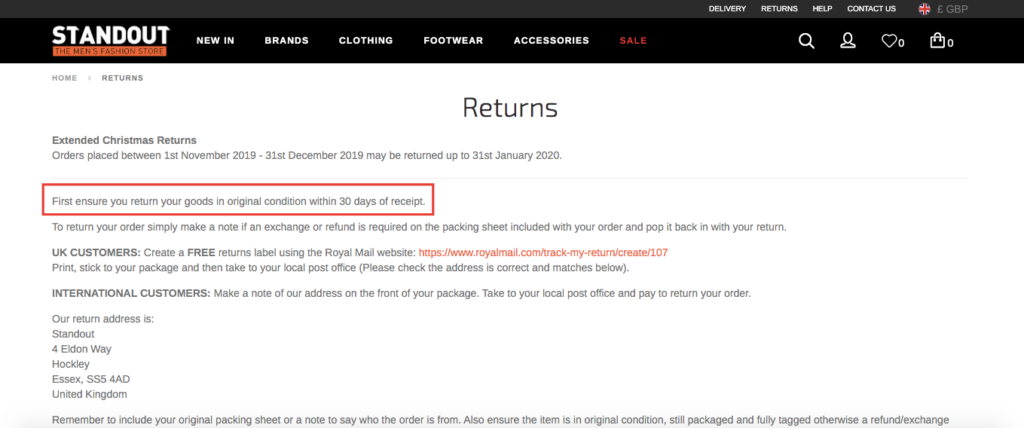 This is smart because shoppers don’t have to do a lot of digging to find the refund policy length. It’s front and center. And while I’m on the topic, you may be wondering how much time you should give customers to make a return.
This is smart because shoppers don’t have to do a lot of digging to find the refund policy length. It’s front and center. And while I’m on the topic, you may be wondering how much time you should give customers to make a return.
According to extensive research, 30 days is a good number, with 53 percent of customers saying this was a fair length of time.
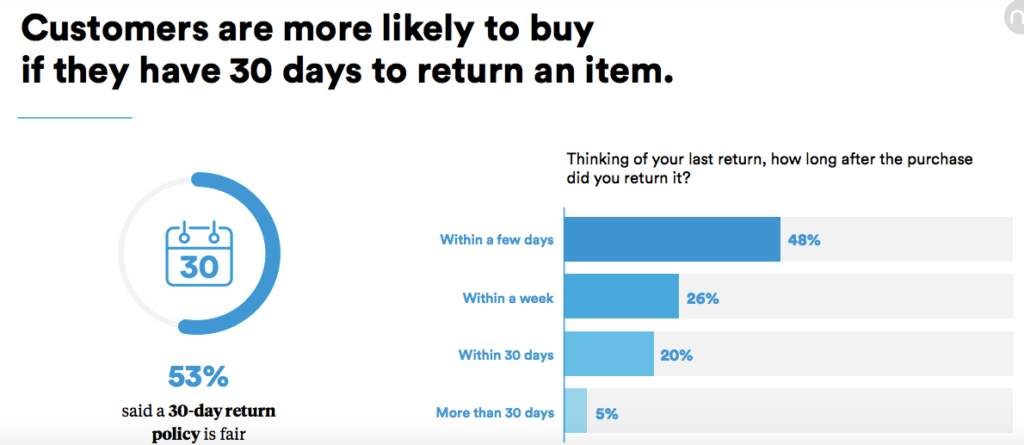 As you can see from the graph on the right, only 5 percent of customers waited more than 30 days to make their last return, so this should be sufficient for most brands.
As you can see from the graph on the right, only 5 percent of customers waited more than 30 days to make their last return, so this should be sufficient for most brands.
2. The Cost of Making a Return
The next thing customers will want to know is how much they’ll have to pay (if anything) to make a return.
So I suggest placing this information just below the return policy length.
That’s what environmentally friendly shoe company Allbirds does on their page.
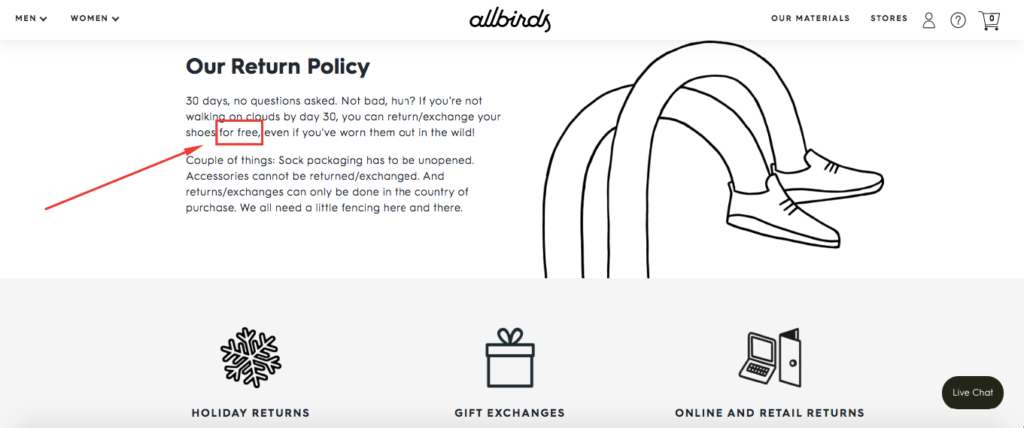 You’ll also notice that they allow customers to make a return free of charge—something that’s extremely important considering 79 percent don’t want to pay for return shipping.
You’ll also notice that they allow customers to make a return free of charge—something that’s extremely important considering 79 percent don’t want to pay for return shipping.
“In a world where nobody wants to pay for shipping at online stores, to begin with, you can bet that customers won’t be that happy about spending good money to send an item back,” explains ecommerce CRM platform ReadyCloud.
While it will take a chunk of your profit margins, the increase in long-term customer loyalty and repeat sales usually justifies it.
That’s why I recommend crunching the numbers to see if this is a financially feasible move for your company.
3. Receipt Policy
Some brands have strict policies where a customer is required to have a receipt to make a return with no exceptions.
Considering how easy it usually is to retrieve a digital receipt through email, this shouldn’t be a problem for your customers.
Others are laxer and don’t require a receipt as long as a customer can provide other information to locate the purchase.
Either way is fine, but it’s important to let shoppers know what your receipt policy is.
Nordstrom does a good job of addressing this on their returns page, where they explain that having a receipt makes it faster for them to locate a purchase but isn’t required as long as they can find a record of sale or a customer is willing to provide them with personal information.
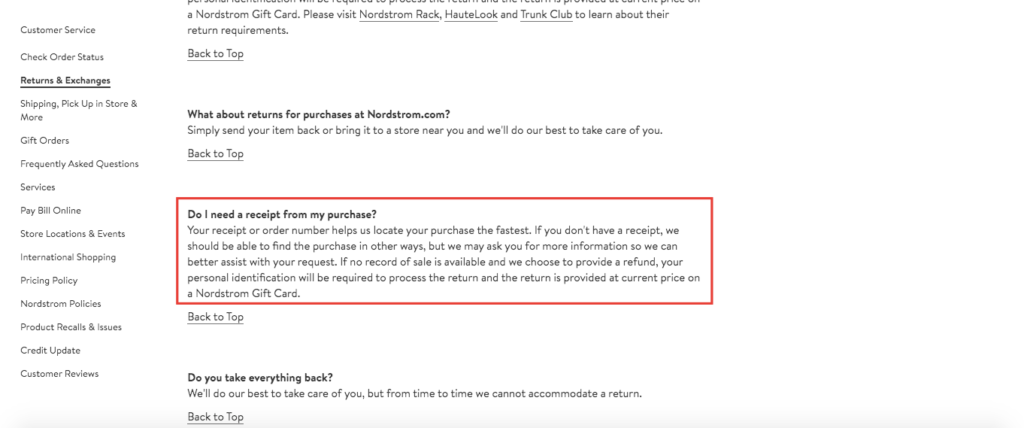 Letting shoppers know what your receipt policy is can save them as well as your company time because you can reduce any back-and-forth.
Letting shoppers know what your receipt policy is can save them as well as your company time because you can reduce any back-and-forth.
4. Damaged Items Policy
Did you know the top reason 20 percent of ecommerce customers return an item is because it’s damaged? That’s one out of every five.
I find that number shockingly high and shows how important it is to address your policy on damaged items.
Milani Cosmetics is straightforward about this and says they’ll give customers a refund or exchange for any items that are damaged.
They need to email them pictures first.
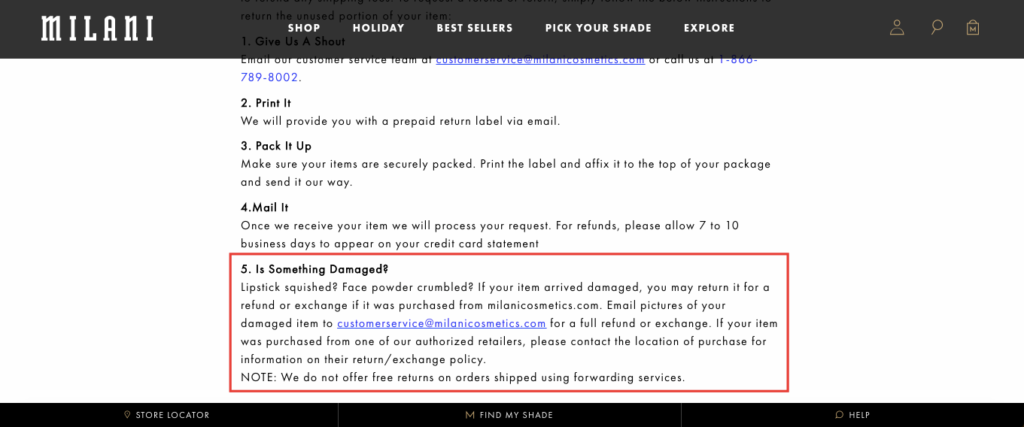 Including this information ensures you’re on the same page right from the start, and customers will know what to do if they receive a damaged product.
Including this information ensures you’re on the same page right from the start, and customers will know what to do if they receive a damaged product.
5. Product Condition Requirements
Companies can vary in terms of what type of condition a product has to be returned.
For instance, on-demand t-shirt company Zazzle allows its customers to return a product regardless of the condition without any special stipulations.
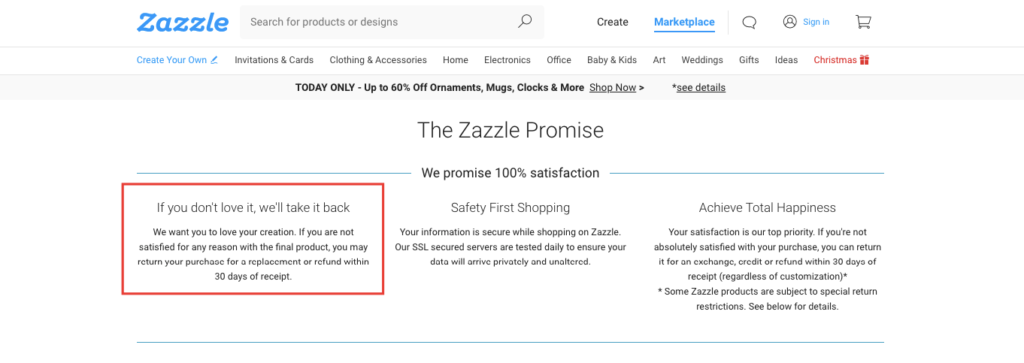 Allbirds has a policy where sock packaging has to be unopened to be eligible for a return.
Allbirds has a policy where sock packaging has to be unopened to be eligible for a return.
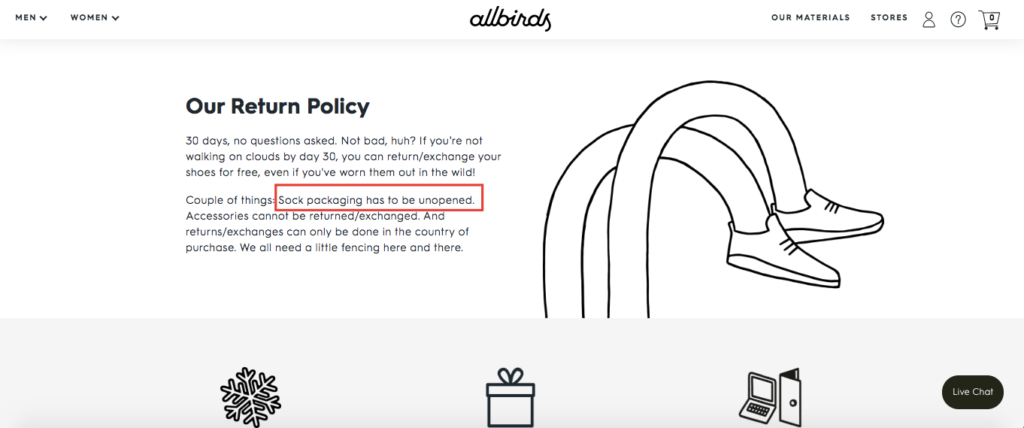 They also point out that accessories can’t be returned or exchanged.
They also point out that accessories can’t be returned or exchanged.
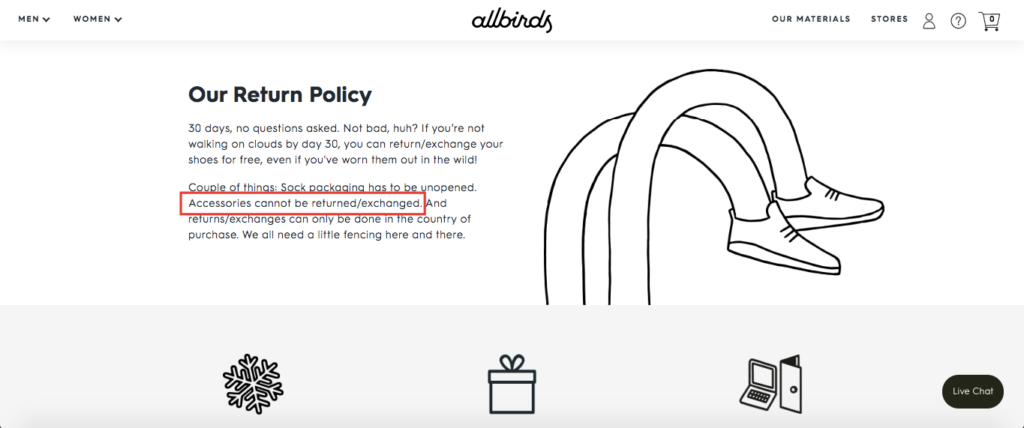 And men and women’s clothing store Oak Hall explains that items must be unworn, unwashed, and undamaged.
And men and women’s clothing store Oak Hall explains that items must be unworn, unwashed, and undamaged.
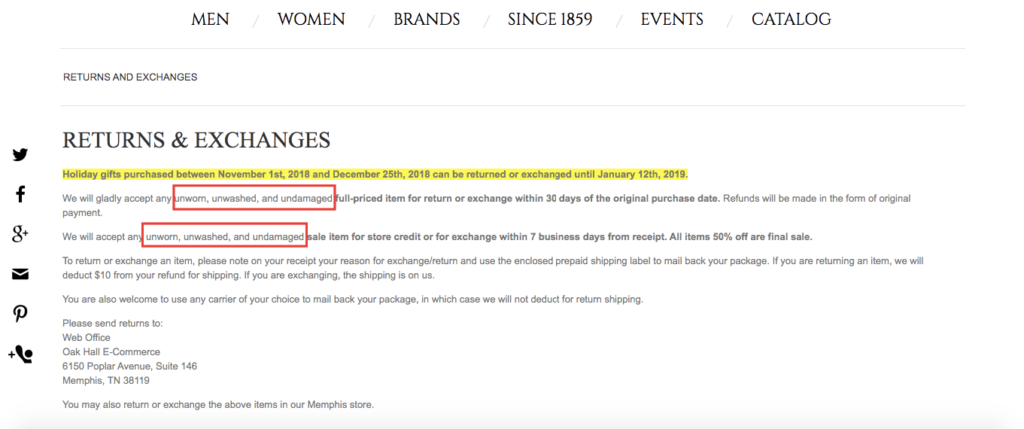 So this is another vital element you should include when writing refund policies.
So this is another vital element you should include when writing refund policies.
Being upfront about product condition requirements, as well as specific products that can’t be exchanged, creates instant transparency, and tells shoppers what they need to know.
This can go a long way in building trust and rapport.
6. Where Funds Will Be Deposited
Another common question customers have is how they’ll be credited after receiving their refund. Will the money be deposited back into the debit or credit account they used to pay for an order? Will they receive a gift card? Can they receive cash?
To ensure a positive customer experience, you’ll want to make it crystal clear which options are available.
For instance, Nordstrom states, “All refunds will be credited to your original form of payment or a Nordstrom Gift Card.”
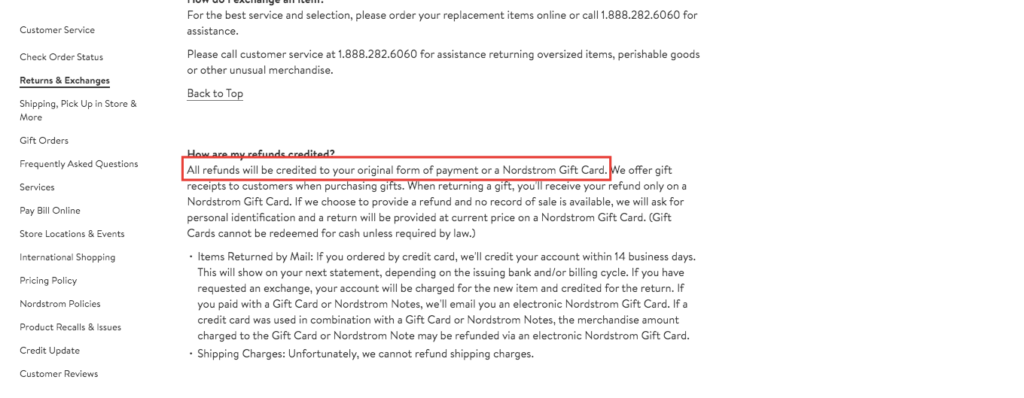 This brings me to my next point.
This brings me to my next point.
7. Replacements or Exchanges
In some cases, customers want their money back, and that’s it.
However, many will be interested in exchanging an item for another one or getting store credit, as Nordstrom offers with their gift cards.
In fact, 28 percent of shoppers like returning a product when they can shop for other items, and 35 percent like returning an item when they get immediate credit.
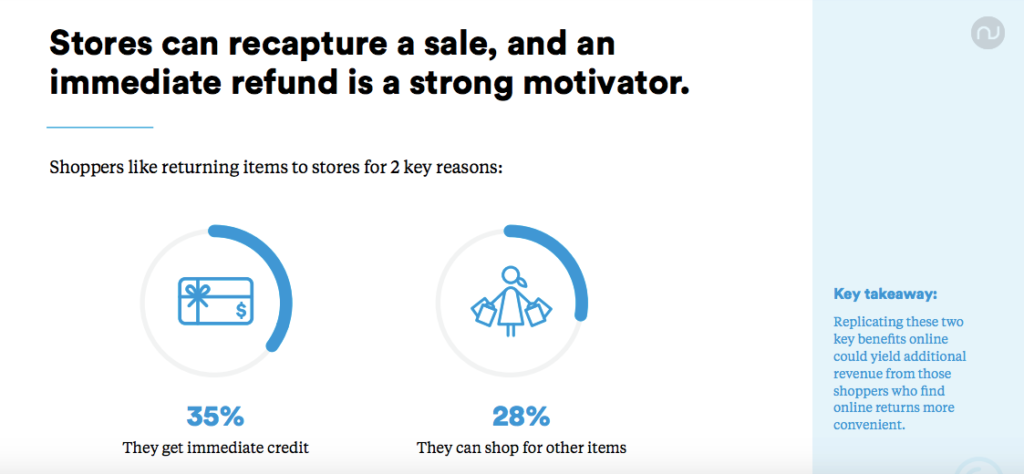 So you’ll want to mention your policies regarding replacements or exchanges and whether or not this is something you offer.
So you’ll want to mention your policies regarding replacements or exchanges and whether or not this is something you offer.
This is something women’s clothing company GitiOnline touches on right off the bat.
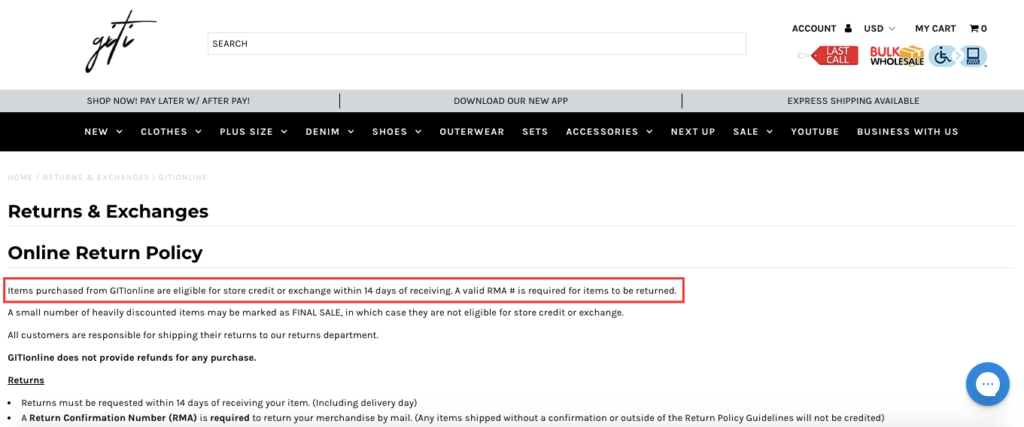 They also make it clear that a small number of heavily discounted items can’t be replaced or exchanged.
They also make it clear that a small number of heavily discounted items can’t be replaced or exchanged.
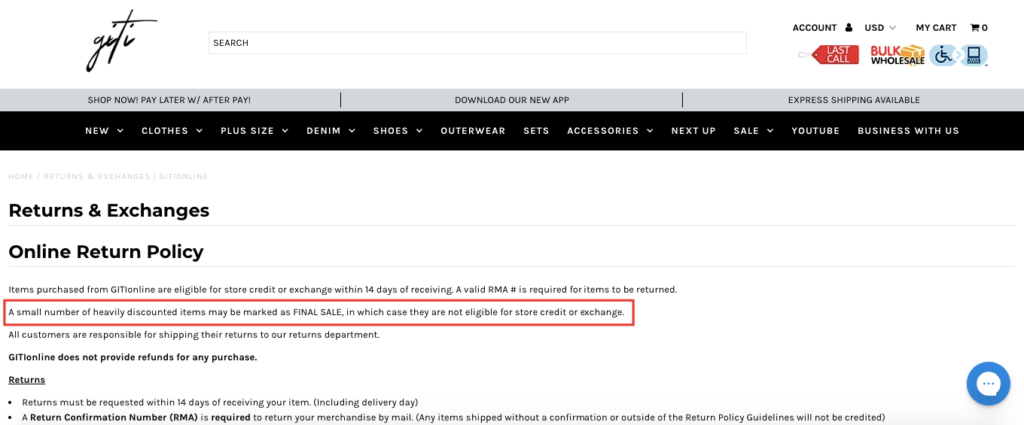 Failing to mention any exceptions like this could create friction with customers, so keep this in mind when incorporating this information into your refund policies.
Failing to mention any exceptions like this could create friction with customers, so keep this in mind when incorporating this information into your refund policies.
8. Processing Time
You’ll also want to address how long it will take for a refund to be processed. This is important because the processing time heavily impacts the overall customer experience.
More specifically, slow processing makes customers far less likely to refer your brand to others or buy from you again.
Research has found:
- Seventy-seven percent of customers are less likely to recommend a brand that takes too long to issue a credit;
- Forty percent will stop shopping online with that brand; and
- Forty percent will limit their shopping with that brand.
I know that I get annoyed whenever it takes forever to get my money back.
So not only do you want to specifically mention how long it will take—like Milani Cosmetics does below—you should do your best to expedite the process.
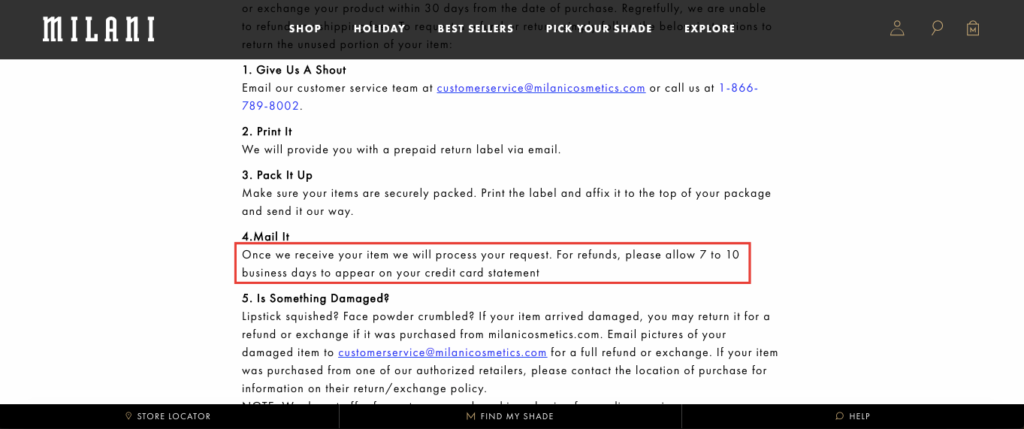 If you’re wondering how long shoppers are willing to wait on average, here’s some data I found.
If you’re wondering how long shoppers are willing to wait on average, here’s some data I found.
- Seventy-two percent are willing to wait five days;
- Twenty-four percent are willing to wait ten days;
- Three percent are willing to wait 20 days; and
- One percent are willing to wait more than 20 days
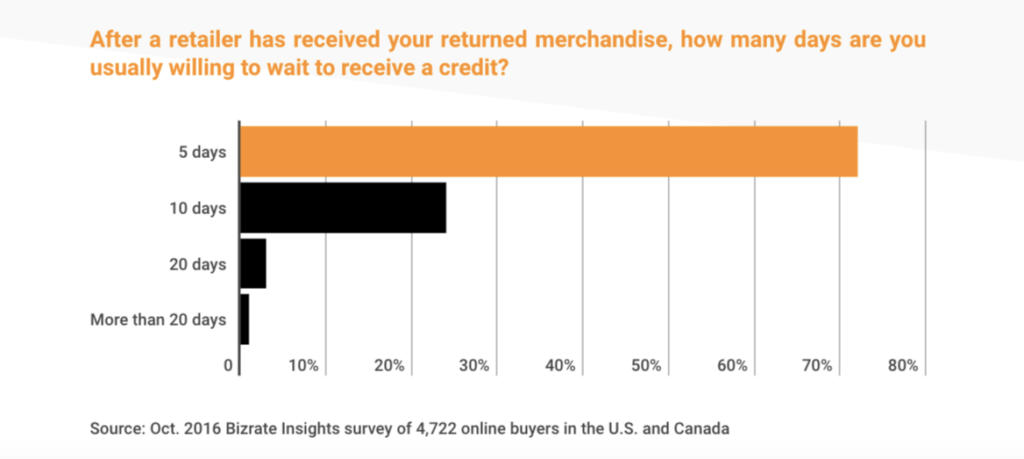
So keeping it under five days is ideal. However, you should still be in relatively good shape if your processing time is no longer than ten days. Also note, that you’re pretty much guaranteed to run into problems if it exceeds 20 days.
9. How to Get a Return Label
Finally, you’ll want to let customers know where they can find a return label. The last thing you want is to have them struggle to print this out and send their item back. So do everything within your power to streamline things.
I like how Standout offers a super easy to find link on their returns page.
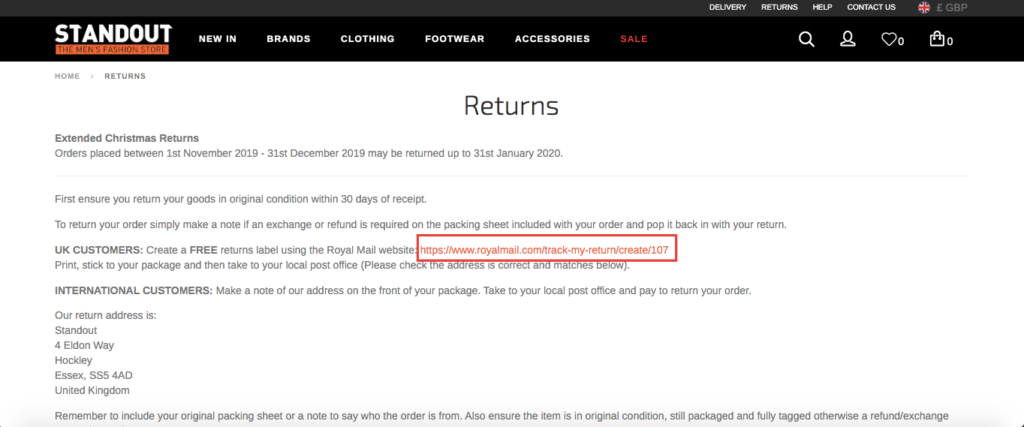 All you have to do is click on it, and they guide you through a simple three-step process where you can print out your label from home.
All you have to do is click on it, and they guide you through a simple three-step process where you can print out your label from home.
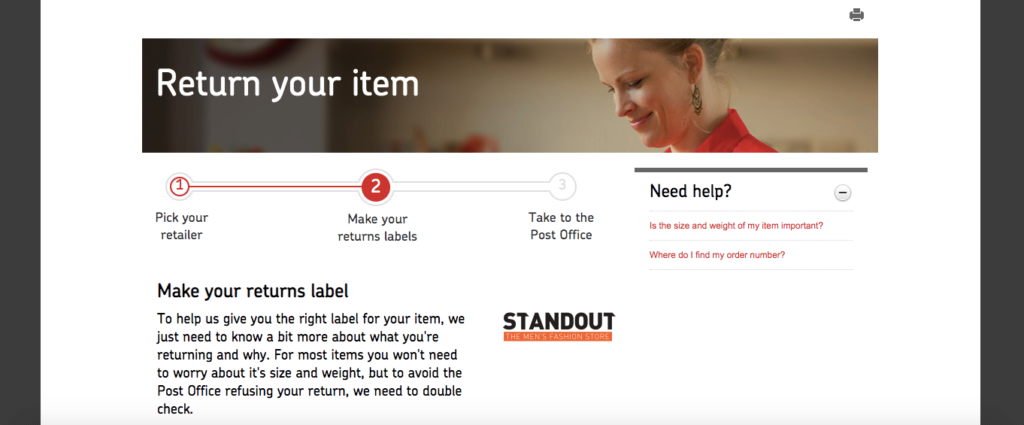 So I think this is a great template to follow.
So I think this is a great template to follow.
Return Policy Best Practices: What To Include
What makes a return and refund policy effective?
It's all about the details.
Your policy should be clear and state all potential scenarios. A policy that explains all the ins and outs fosters customer trust.
So, what should I include? Let's go through the most crucial things. I feel like ASOS has a well-explained returns & refund policy, so let's include an example from them for each one.
- How to return items. Show customers how to process a return. It should include the steps they need to take and any contact information they may need.
- How to get refunds. Provide information on how customers can receive their refunds, including how long it takes, the steps needed for it, and what type of payment method is accepted.
- How to exchange items. Regardless of whether you accept product exchanges or not, provide customers with detailed information on the specific procedures your brand has for it.
- Stipulations and exclusions. Let customers know what's not eligible for returns, such as items that have been used or are no longer in their original condition.
- Time to return, refund, or exchange. Make it clear how much time customers have for returning items, as well as the expected processing times for the refund. The same applies to product exchanges, if you accept them.
- Shipping or restocking fees. If necessary, inform customers of any fees they'll need to pay during the return process, or if you offer free returns.
- International returns, if applicable. When selling to customers overseas, provide information on how they can return items and receive a refund or exchange.
- Contact information. Make sure to include contact details so that customers can get help with their returns if they need it.
Return Policy Template to Download (Go Ahead, Steal It)
[Your Company Name] Return Policy
Effective Date: [Date]
We strive to provide our value with excellent products and services, but occasionally, you may need to return or exchange an item. This return policy outlines the guidelines and procedures for returning items, obtaining refunds, exchanging products, and other relevant information.
Please read this policy carefully to understand your rights and obligations.
How to Return Items
To initiate a return, please follow these steps:
1. Contact our Customer Service Team at [Contact Details] within [number of days] days of receiving your order.
2. Provide your order number, item(s) to be returned and the reason for the return.
3. Our Customer Service Team will guide you through the return process and provide you with a Return Merchandise Authorization (RMA) number.
4. Package the item(s) securely, including all original packaging, accessories, and documentation.
5. Clearly write the RMA number on the outside of the package.
6. Ship the item(s) to the address provided by our Customer Service Team.
Please note the following conditions for returns:
a. The item(s) must be unused, undamaged, and in the same condition as when you received them.
b. Items that are not eligible for return include [list any specific exclusions or stipulations].
c. Returns without a valid RMA number may not be accepted.
How to Get Refunds
Once we receive and inspect the returned item(s), we will process your refund.
1. If you paid by credit card, the refund will be issued to the original payment method within [number of days].
2. If you paid by any other method, our Customer Service Team will guide you through the refund process.
Please note the following conditions for refunds:
a. Refunds will only be provided for eligible returned item(s) as per our return policy.
b. Shipping and restocking fees (if applicable) may be deducted from the refund amount.
How to Exchange Items
To request an exchange for a different product, please follow the return process outlined in Section 1.
1. In your return request, clearly state that you would like an exchange.
2. Provide the details of the new item you would like to receive. New items should have the same value or less.
Please note the following conditions for exchanges:
a. Exchanges are subject to product availability.
b. If the requested item is of higher value, you may be required to pay the price difference.
Stipulations and Exclusions
The following stipulations and exclusions apply to returns, refunds, and exchanges:
a. [List any specific conditions or restrictions, such as opened software, personalized items, or perishable goods].
b. [Specify any non-returnable or non-refundable items, if applicable].
c. [State any requirements for packaging, labeling, or restocking fees, if applicable].
Time to Return/Refund/Exchange
All returns, refunds, and exchanges must be initiated within [number of days] days of receiving your order.
Shipping/Restock Fees
Return shipping costs are the responsibility of the customer, unless the return is due to our error or a defective product.
In such cases, please contact our customer service team for further assistance.
Restocking fees may apply for certain returns, depending on the nature of the product and its packaging condition. For more information contact out customer service.
International Returns (if applicable)
For international returns, please contact our customer service team for specific instructions and information regarding return shipping and customs requirements.
Contact Details
For any questions, concerns, or assistance related to returns, refunds, or exchanges, please reach out to our Customer Service Team:
Email: [Email Address]
Phone: [Phone Number]
Live Chat: [Website URL]
We value your satisfaction and will do our best to resolve any issues promptly and efficiently.
Please note that this return policy may be subject to change without prior notice. The most current version will be available on our website.
Thank you for your cooperation and understanding.
[Your Company Name]

Wrap Up
The question "How to write a refund policy" depends always on the business.
Sure, the basics remain the same, but for each store, there are business-specific details that should be taken into consideration, such as the type of refund policy.
For example, North Face has a unique return policy, including its lifetime warranty, and ASOS has a different return policy designed to match their vast selection of products.
In the same way, you should craft a return policy that meets the specific needs of your customers while also protecting your business.
Just like how a return policy helps build trust and loyalty with your customers, so does a great email program.
Sending the right message to the right person at the right time can make all the difference between you and your competition.
And Drip can help you send those lifecycle-critical emails that help you build real relationships with your customers and further solidify their trust in your brand. Try Drip absolutely free for 14 days!


